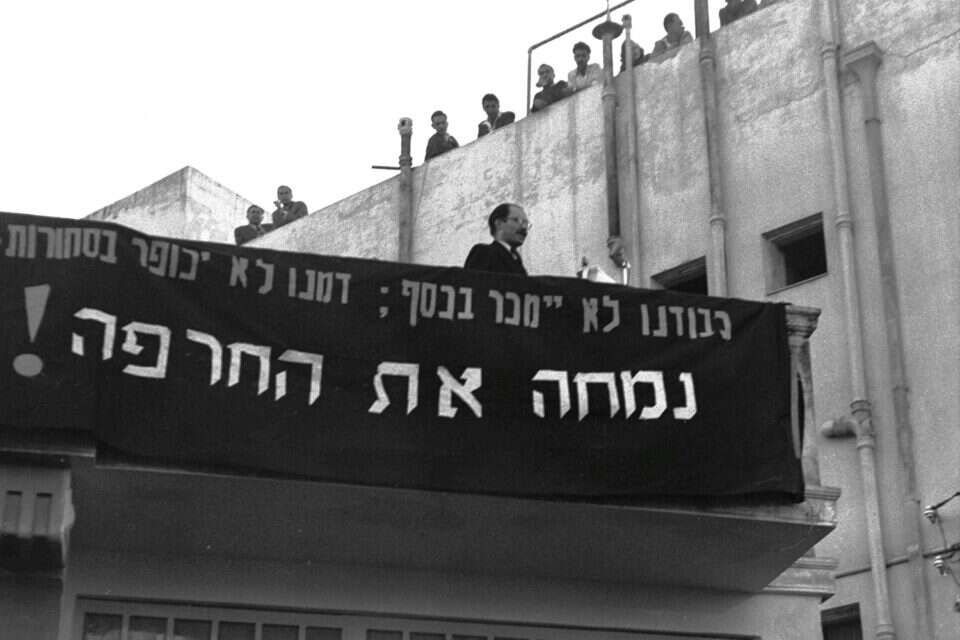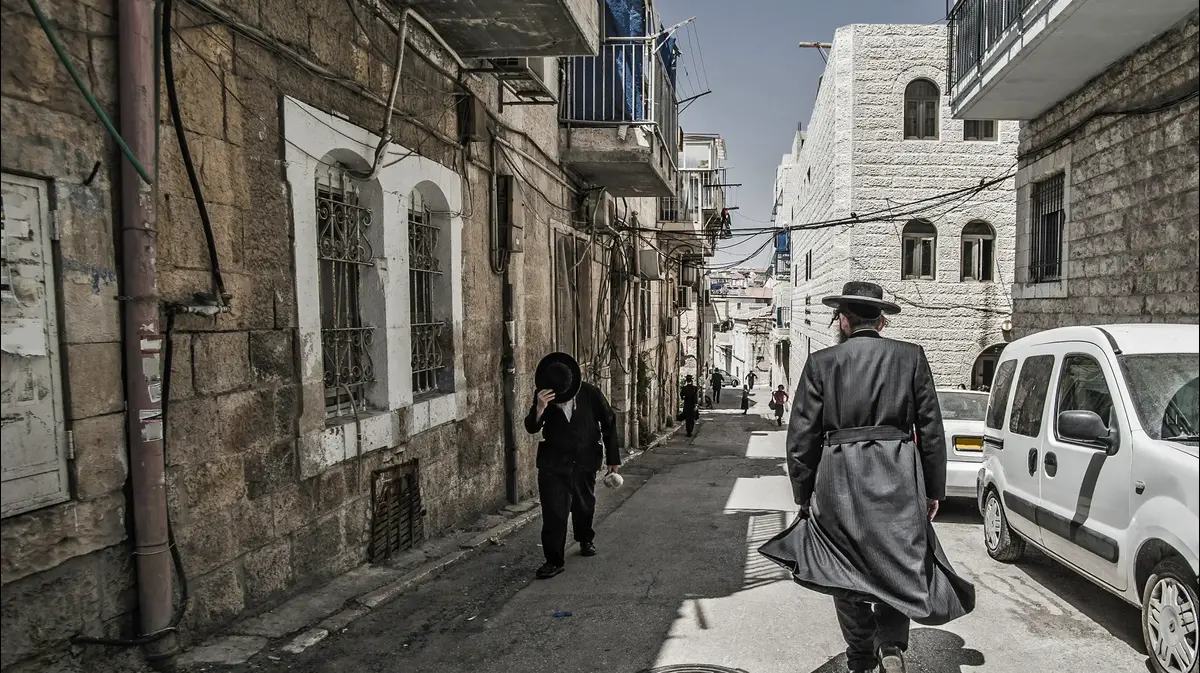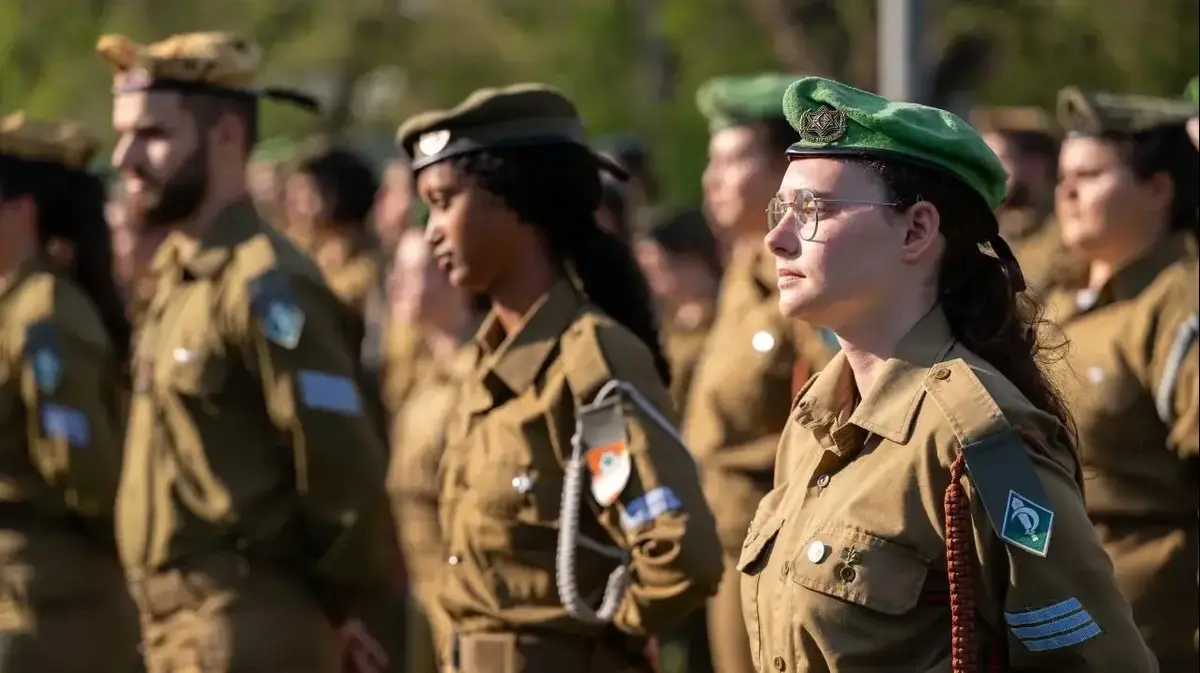Fateful vote in the Knesset
On the morning of Wednesday, January 9, 1952, great tension was felt in Jerusalem ahead of the Knesset session scheduled for 09:45.
The MKs were to vote on a fateful issue: approve or reject the government's request to open negotiations with Germany on the reparations that the Germans would pass as compensation for the burden on Israel in absorbing destitute Jewish refugees who were displaced and lost their assets during the Holocaust.
All the streets around the Knesset building, which was located in the "Frumin House" on King George Street in the city, were blocked to traffic.
Police set up barbed wire barriers, and no one was allowed to enter the fenced area except the MKs and local residents.
Police guards patrolled the fenced area and outside it, making sure to disperse any crowd of more than three civilians.
The army was stationed outside the city and was in a state of readiness, as were hundreds of workers who arrived in organized buses from all over the country, to "defend the homeland," as they defined it.
The reason for the great tension was related to events that took place in the capital two days earlier, on January 7, 1952: At the end of a stormy demonstration in Zion Square, led by Herut movement chairman MK Menachem Begin, who opposed contacts with Germany, protesters marched toward the Knesset building. The police checkpoints - while injuring about 100 policemen - began to throw stones at the Knesset windows, which caused great panic among those present in the building.
In the end, the Knesset voted that morning in favor of holding negotiations with Germany, and MK Begin was removed from the Knesset for a period of three months.
Demonstration poster, photo: from the archives of the Jabotinsky Institute
Rise of academics from England: "We need experts here"
An engineer from England and his wife in Tel Aviv, 1952, Photo: From the Sclerts collection, "Beitmona" website
In young Israel, longing for the addition of academics and experts to help its growth, they were very happy to hear the following news: In January 1952, the Jerusalem delegation of the Patra Zionist Association, based in London, received encouraging reports of "growing interest in Israel" among Jewish communities in Britain.
The purpose of the "Patra" association, which was established even before the War of Independence, was to assist in organizing the immigration of academic Jews with professions that were more in demand in those days in Israel.
In the period before the War of Independence, "Patra" helped more than 100 doctors, engineers, lawyers and other freelancers from British Jewry to immigrate to Israel.
"We are clear about the importance of our activities for the influx of Jewish academics and experts into Israel," wrote Edwin Samuel, chairman of the Patra organization, in a statement issued on January 14, 1952, by the association's representatives in Jerusalem.
"During 1951-1950 we assisted in the further immigration of 200 Jewish experts, and in our plan to locate, persuade and assist the immigration of at least 100 more experts this year," Samuel concluded.
In the years that elapsed between the establishment of the State of Israel in 1948 and 1950, most of the Jewish aliyah from England was organized as part of the "Aliyat Halutzim," whose members received agricultural instruction on farms in England, and upon their aliyah were immediately absorbed into farms in Israel.
These farms were in contact with the pioneer groups in England many months in advance.
"We are now required to focus on the rise of specialists," reported Chairman Samuel, "since the Technion in Haifa provides less than 40 percent of Israel's annual needs in engineering, and the Hebrew University of Jerusalem is also limited in its ability to provide qualified physicians, teachers, nurses and government officials."
Emergency conference of glaziers
Phenicia Factory in Haifa, 1953, Photo: Zoltan Kluger, GPO
Immediately after its establishment in 1934, and for decades, the activities of the "Phenicia" glass factory were characterized by malfunctions and temporary production interruptions, accompanied by the risk of continued closure and fears of foreclosure proceedings, along with frequent transfers, labor disputes, reductions and strikes.
In the 1940s, Phenicia was acquired by the Histadrut 'Solel Boneh', which succeeded in 1950 with its ties in abolishing the supervision of the glass market in Israel, and at the same time stopping imports of glass surfaces into the country.
The halt in imports and the abolition of supervision caused a jump in glass prices, and a black market developed in the industry, stemming from the permission given to contractors to purchase glass directly from the factory and at a discounted price.
This permission was used by some of the contractors for orders beyond their needs - when the surpluses flowed into the black market.
In 1951, in an attempt to regulate the wild glass market, ten wholesale marketers were set up across the country, selling exclusively Phenicia glass to hundreds of retail glaziers.
However, in the absence of supervision, the wholesale marketers began to provide glazing services themselves to each applicant.
At an emergency conference held on January 15, 1952 in Kiryat Shaul in Tel Aviv, the retail glaziers complained that the marketers were allocating only a tenth of the amount of glass they ordered each month, and that too at exorbitant prices.
"They want to strangle us," cried the chairman of the Glaziers' Association, Ezekiel Hoffman. "It is already better for us to buy glass on the black market.
And who comes out lost?
"Residents who order glazing and receive shock from the price they are required to pay for repairing a window or glass door."
Call in the Histadrut: "Raising the Basic Wage"
In light of the rise in product prices in Israel, which has been evident since mid-1951, the Histadrut Executive Committee has begun discussing the demand for wage increases in the various sectors of the economy.
Pinchas Ben-Dori, a representative of the opposition Mapam, demanded an increase of no less than 30 percent in basic salaries, "since the increase in cost that is supposed to compensate for the rise in the index (index) does not in fact cover the entire rise in prices."
The representative of the "Zionist Worker" in the Histadrut, Israel Shaarei, demanded "equal pay for basic wages in all industries," and the representatives of the other parties also joined in with their own wage demands.
The Minister of Finance, Eliezer Kaplan, refused to raise wages without linking them to an increase in output, and promised that "an American expert with a reputation in the field of wages will soon arrive in Israel, who can advise the Israeli government from his vast experience."
More than 3,200 GDNAs: a year to experience Beer Ora
GDNA Order in Beer Ora, Photo: Source: Daniel Ventura
"In the first year of its establishment, more than 3,200 youths studied GDNA at the Beer Ora farm," said GDNA commander Akiva Atzmon in a solemn ceremony held at the farm in early January 1952. Guests of the ceremony watched a performance by the GDNA choir and heard greetings sent On behalf of the Chief of Staff, Major General Yigal Yadin, and the Minister of Education, Ben-Zion Dinur.
Atzmon reported to those present that due to the success of the GDNA activity in Beer Ora, the General Staff and the Ministry of Education are considering extending their stay at the farm to one-month cycles a year - instead of the two weeks that were customary until then.
Ramat Gan grew by a third: 42,000 residents
Ramat Gan flourishes: In early January 1952, the head of the council, Avraham Krinitzi, announced that in 1951 the population of Ramat Gan had increased by a third, and now numbers 42,000 residents, "of whom 1,018 were born during the year, and the rest were new immigrants or old residents who moved to Ramat Gan. ".
The contractors' representative, Shalom Sheetrit, said that in 1951 "2,000 apartments were sold on the site, not including immigrant housing built by organizations and institutions."
The missing / cars that were
Messerschmitt
Messerschmitt car, model 1960,
Messerschmitt was a German aircraft factory, which after the defeat of Germany in World War II was banned from producing aircraft.
Starting in 1955, the factory offered a small, light and compact car that suited the ascetic and frugal German character.
Beginning in 1961, Messerschmitt also had a representation in Israel, and although the car attracted attention in its appearance, it did not buy the heart of the average Israeli, who was looking for a car with engine power - while Messerschmitt offered a modest power of only 10 hp.
The grocery store / items since
Grater
Photo: Nostalgia Online Archive,
A necessary and common item at the time in any kitchen, which helped in the preparation of strips of cucumbers or carrots, as well as in the creation of tomato paste.
The vegetables were moved in a quick manual motion, back and forth, across the protruding grater - whose sharp lips were used for cutting.
Initially, the grater was made of poor quality tin, and later of stainless steel.
The culmination of the refinement was in the number of grates put together, each offering a different form of cutting or crushing - in the era before the electric food processor.
Tu B'Shvat - despite the shemita
Tu B'Shvat 5712 was celebrated in Israel in a moderate way, since 1952 was a year of shemita, and in schools the holiday was celebrated only in ceremonies, without plantings.
Despite the restriction, in the transit camps of the immigrants in the Judean mountains, the children planted tree seedlings, under the guidance of members of the Jewish National Fund.
In Jerusalem, the Tu B'Shvat celebration took place in Gan Hashoshanim, while in Tel Aviv, kindergarten children and elementary school students gathered at the municipal nursery (pictured), which was located on the site of the Heichal Hatarbut in 1957. The older students in the city went out to plant seedlings in Gan Meir.
Ads that were
Do you have pictures or souvenirs from the first days of the country? Write to us: Yor@ShimurIsrael.Org
Were we wrong?
Fixed!
If you found an error in the article, we'll be happy for you to share it with us









